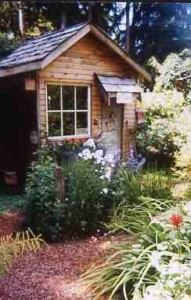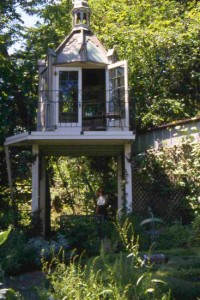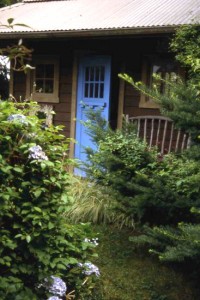Creating Backyard Destinations
Escape to your great outdoors
The lowly shed has been updated and turned into a glorious garden oasis. A look at architectural styles and the people who create sheds.
This lecture includes several years of design ideas and inspiration gathered as Debra and photographer Bill Wright collaborated on “Stylish Sheds and Elegant Hideaways,” a book about the architecture and interiors of backyard sheds (published April 2008 by Clarkson Potter/Random House).

Crafted from salvaged barnwood and recycled windows by Janie and Billie Fowler of Snohomish, WA, this shed is a charming focal point in a country garden.
In the lecture, I explore the many ways people are maximizing their small structures, especially for pursuing their passions (be it gardening, art, entertaining, meditation or play). The lecture investigates architectural styles, building materials, ornamentation, placement and execution.
Here is an essay I wrote in 2002 about Shed design:
Sheds: A Short History and Modern Handbook of Ideas
Garden Shed: shed (n). 1. A small structure, either freestanding or attached to a larger structure, serving for storage or shelter. 2. A large, low structure often opened on all sides.
Contemporary definition: a structure designed and built for one’s personal enjoyment in the landscape or garden.
Does form follow function? Sure, because people build backyard sheds for myriad purposes, be it meditation, rest and relaxation, industry (potting up those seedlings) or entertainment.
There’s always been a compelling utilitarian beauty to sheds, dating back to the very simple use of storing tools, seeds and terracotta pots. Perhaps an old shed, covered in a neglected climbing rose or standing slightly askew strikes a chord of the “good old days” when life was slower, when we lived closer to the land.
Whether a shed is new or old, something about it causes us to personalize the structure with vintage furniture, old garden prints, and a wicker chair. We might even take risks with such a small building, decorating it or incorporating architectural finishes that we would never think of attempting on a larger scale in our primary living spaces.

Kathy and Ed Fries elevated a conservatory-style “shed” in order to create a viewing tower. From this magnificent perch, they can admire the patterns of their lovely circular knot garden from above.
In my forthcoming book about these wonderful garden structures, I want to provide a bit of historical context about sheds, dating back to our pre-industrial, agricultural uses. Next, I’ll look at the post-war shed, the pre-fabricated hut that thousands of suburban families ordered from Sears Roebuck for storing their lawnmower and patio furniture.
And then I’ll fast-forward to the innovative, creative and highly personal garden sheds that architects, garden designers and artists are building. What determines a successfully executed shed? Siting, materials, scale and decorative finishes clearly help certain sheds stand alone as one-of-a-kind garden art and architecture.
As with the architectural character of homes, sheds reflect some distinct regional styles. Yet their owners continue to discover delightful new uses for these small-scale backyard structures. Three themes come to mind: functional (for work, be it horticultural or not), spiritual (for meditation and other contemplative pursuits) and artistic expression.
Instead of separating each chapter with a stand-alone essay about a specific shed in a specific garden, Sheds will have a full-length chronology that blends architectural and horticultural interests. The book will include historical tidbits, facts and anecdotes (with as many western references as possible). Conversations with architectural and design academics and interviews with designers, builders and architects (i.e., Seattle craftsman John Akers, whose sheds made from salvaged barn wood are going for upwards of $15,000; and San Francisco artist-builder Barbara Butler who turns adults’ fantasies into colorful, magical places with her hand-crafted structures made from redwood and cedar; and a few compelling individuals who have created delightful potting sheds for their own use.)

It’s fitting that the hydrangea’s blue-mophead blooms echo the brilliant hues of Rosalie and Cliff Bailey’s garden shed — the scene creates a pleasing surprise in their country garden.
The book’s other voice, of course, will be the users of these wonderful shelters: gardeners who truly spend their most gratifying hours just steps away from the back door . . . in a backyard sanctuary. Here, we need to look inside the sheds to appreciate the interiors, both humble and highbrow. What’s important? Shelves, benches, sinks, greenhouse-style windows, French doors, a place to sit, a place to nap, music, fragrance, etc.? What does the presence of a shed really provide other than facilitating delightfully lazy lolling around?
The book will conclude by offering resources (web, print, suppliers, and a bibliography of ideas). I’ll finish up with an essay that touches on the most personal and private uses of backyard sheds, quoting from the region’s many garden ‘philosophers’ who can speak first-hand about the sense of separateness – of place – offered by their own shelters. And perhaps we’ll learn a bit about why sheds are so beloved and what they say about our near environment.








